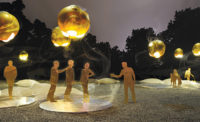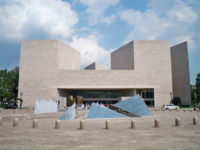Sean Carlson Perry, founder of an eponymous Brooklyn, New York-based full-service design firm, has worked on high-end residential and commercial interiors, luxury retail projects, graphics, and furniture design. Perry, 31, is also the founder of Design Exchange, a new project to create comfortable living environments for those in need.
 |
| Photo courtesy Sean Carlson Perry Sean Carlson Perry, founder of Design Exchange |
Working with two part-time interns and a handful of volunteers and subcontractors, Perry helps provide formerly homeless individuals and families, including those coming out of shelters, with the basics for their living space, including furniture, project materials, and free design services. For every project completed for one of Perry’s paying clients, 10 percent of the design fee is donated to Design Exchange. In order for the model to work, Perry has partnered with nonprofits such as The Ali Forney Center and Bottomless Closet NYC and launched a Design Exchange crowdfunding campaign to help cover start-up costs and to fund the first two projects.
Can you tell us a little bit about your background?
I grew up in Omaha, Nebraska. I first went to college at Arizona State University in Tempe and thought I wanted to study business and marketing. After realizing that wasn't for me, I moved to Minneapolis, into a 115-year-old Victorian. I worked with my boyfriend, who was also a carpenter, to slowly renovate the space. It was in the process of this that I realized my passion for design and architecture. I enrolled at The Art Institutes International in Minneapolis. My professors told me my concepts were 'too out there,' and a school adviser recommended I check out Pratt. I did my research, applied, packed up, and moved to NYC. Luckily a few weeks after I arrived, I received my acceptance letter from Pratt.
What sparked your interest in creating Design Exchange? Are there any other firms out there, that you are aware of, that are using a similar model?
I am not aware of any other design or architecture firms operating with a model similar to ours in any way. Back when I was a student at Pratt Institute, I set a goal that I would one day have my own firm, and I was always thinking about how my firm would be different and would have a philanthropic aspect. Turning 30, I found myself reevaluating what is important and how I wanted to go forward with my career. I love what I do, but felt compelled to do something with greater purpose and depth—something that helps those in need. Living in New York City, you walk down the street and literally see the struggles of people on a daily basis.
The American Medical Association recognizes the importance of aesthetics and healing, however this issue has not yet been addressed outside of medical facilities. Individuals who are in, or coming out of, shelters and getting back on their feet are in the process of healing. I think we need to take what we know about healthcare design and apply it to the environments of those who are struggling to heal their lives.
What have you learned about designing for the formerly homeless?
The rewards of a well-designed, organized, and comfortable environment should not just be for the privileged. What I have learned in developing and creating our first projects (still in the works) is that there really is a huge need for design in these environments. I realized that people don't think they need design, but it can be influential and empowering. There are so many individuals out there who are struggling to get back on their feet, and simply can't afford the basics for living—things that most middle class Americans could easily afford to buy: a sofa, a bed, some decorations, and a few creature comforts. This is not "Extreme Home Makeover."
Can you tell us more about the cost-saving strategies that you employ in your practice?
We dissected all operations and deliverables of a project to evaluate each component’s effectiveness in relation to the final client need. From there we were able to determine where we could cut, change, or reconfigure processes in order to maximize effectiveness and cut cost. We also evaluated how new technology has created greater efficiency in other fields and examined ways of integrating that technology into our practice. One example is greater collaboration at a higher rate. Holding meetings that include the client, contractors, and suppliers at a higher frequency throughout the design process greatly increases productivity by reducing construction and installation delays due to misunderstandings during the fabrication/construction process.
Another example is operating as a 90 percent paperless office. We administer all client presentations on tablets. By having our clients engaged with design and technology directly, we can run highly efficient meetings, convey clearer design intent, and save cost on paper, toner, maintenance, and time.
What has been your biggest challenge so far with the venture?
The two biggest challenges have been getting people to understand how it works and obtaining funding. Design Exchange partners with key nonprofit organizations to obtain eligible recipients for our projects. Right now we have partnerships with The Ali Forney Center (housing homeless LGBTQ youth) and Bottomless Closet NYC (empowering disadvantaged women to enter the workforce and achieve success). We are always exploring new ways to partner with organizations, businesses, and others in the industry.



Post a comment to this article
Report Abusive Comment